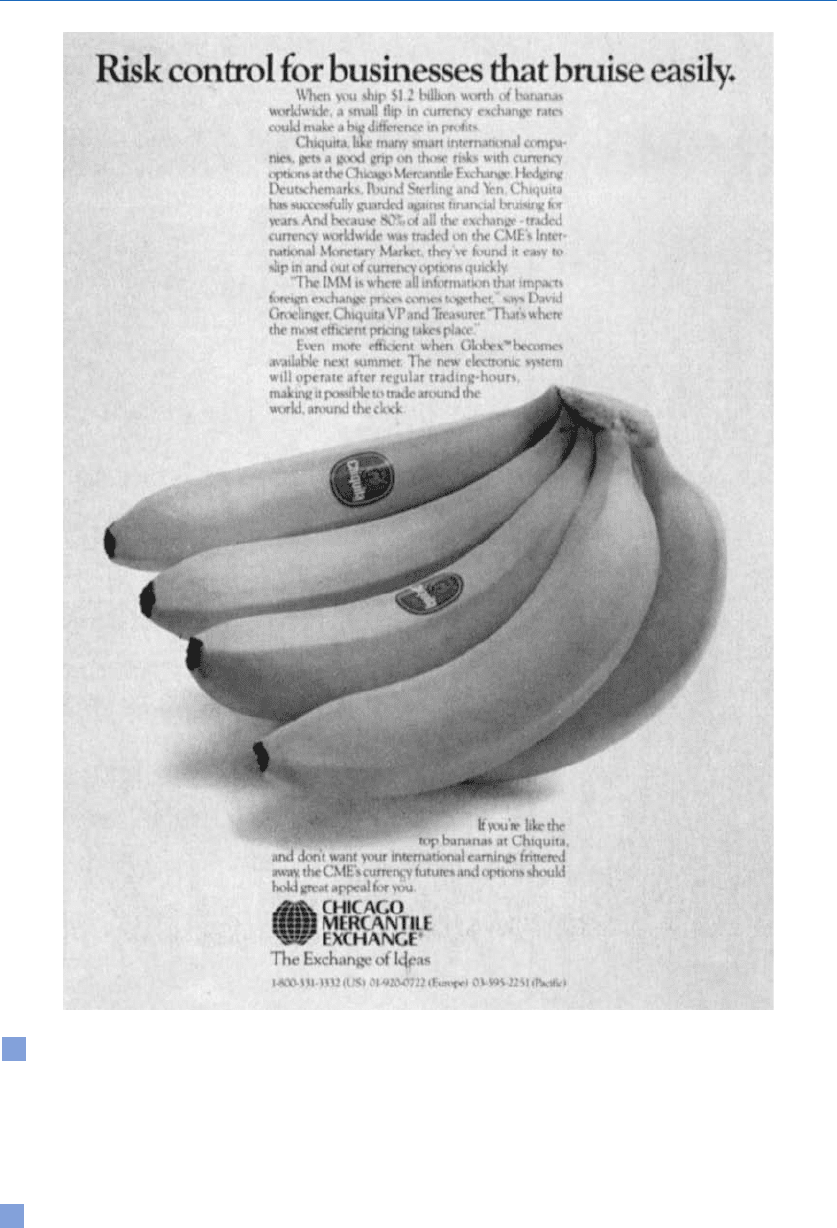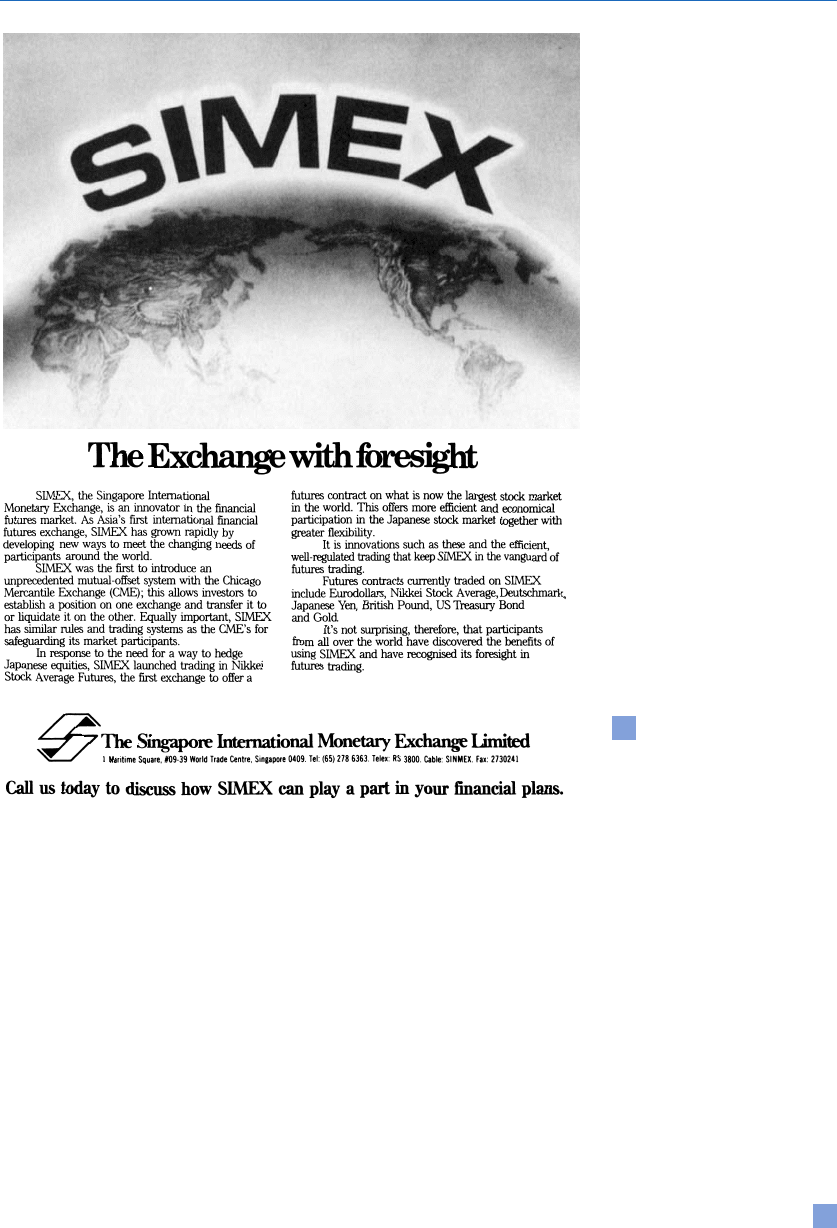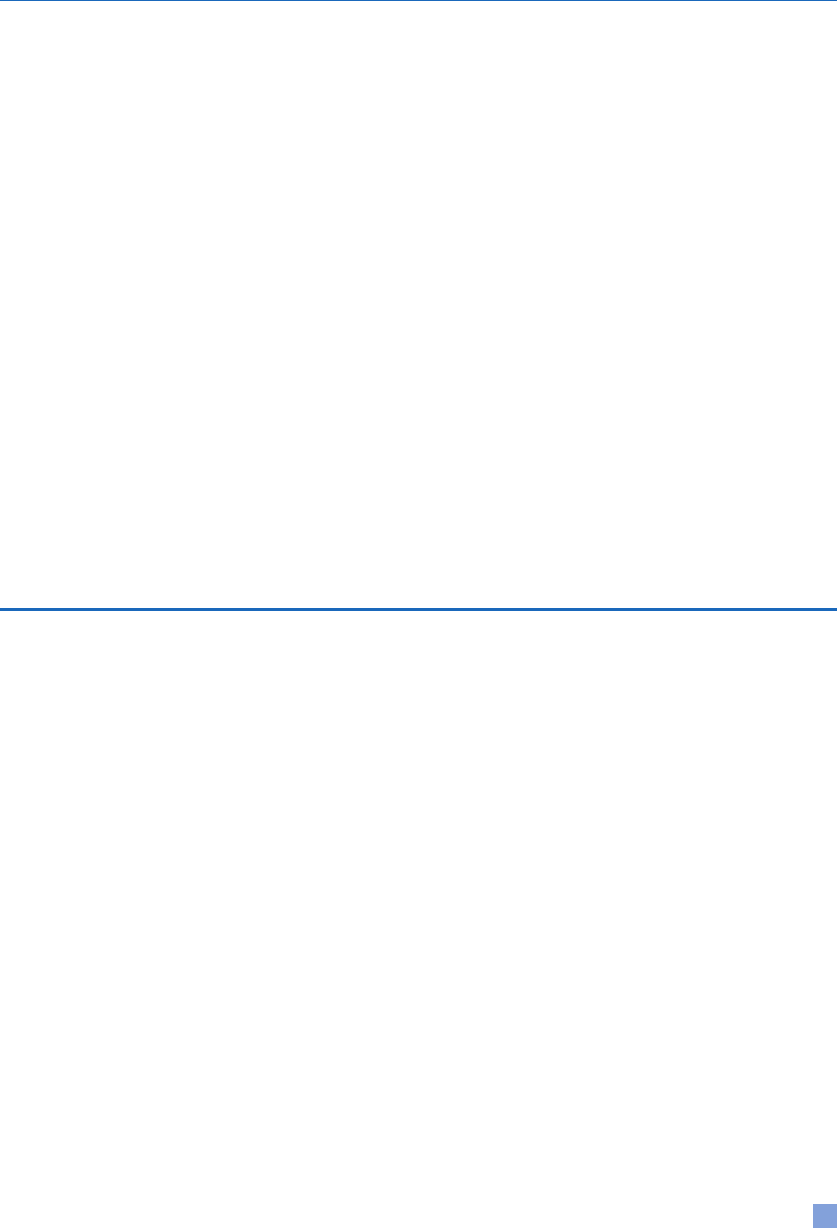Onkvisit S., Shaw J. International Marketing: Analysis and Strategy
Подождите немного. Документ загружается.


During the first few months of 1995, the dollar
dropped by about 20 percent more against the
Japanese yen before beginning a surge of 25 percent.
The euro was introduced at $1.18 to the dollar on
1 January 1999, floated to below 83 cents in
October 2000, and soared to a record high of $1.29
in early 2004; that is, down 31 percent and back up
more than 50 percent in four years with no obvious
economic fundamentals to explain gyrations.
Early warning systems
While exchange rate movements are predictable
at longer horizons based on the countries’ varying
interest rates, business firms have to find some prac-
tical ways to deal with short-term volatility. It may
be worthwhile to consider some early warning
systems.
While some models have as many as twenty indi-
cators, the IMF researchers have developed a simple
five-variable macroeconomic model for an after-
the-event analysis.The indicators are: degree of real
exchange rate overvaluation, size of current account
deficit as a share of GDP, growth rate of exports,
rate of growth of reserves, and ratio of short-term
external debt to reserves. The model worked rea-
sonably well, producing results with relatively high
warning signals for Korea,Thailand, Indonesia, and
Malaysia, but not for the Philippines.
16
Investment banks have been developing their
own in-house models to predict currency crises.
One such economic model is Deutsche Bank’s
Alarm Clock (DBAC).While these models are cer-
tainly not perfect, they seem to be far superior to
some of the alternative indicators often used by the
markets and analysts. Even though there were many
false alarms, the models were able to anticipate
potentially dangerous pressures at work in foreign
exchange markets.
17
In addition, they are objective
and mechanical, thus minimizing analysts’ biases.
Hedging
“Hedges protect yards from dogs and businesses
from financial exposure.”
18
One study found a firm’s
size (as measured by foreign exchange turnover) to
have the most important effect on its risk manage-
ment practices.The effect of size is in terms of the
use of computer technology, the use of both physi-
cal and synthetic products, and the number of both
short-term and long-term foreign funding activities
employed.
19
In practice, size is irrelevant because any prudent
firm must manage foreign exchange risks. One
study focused on the extent to which industry
actively manages rather than hedges foreign
exchange risk. According to the results, 70 percent
of firms trade their foreign exchange exposures, and
some traders do so without internal foreign
exchange dealing limits or controls on their position
taking.The favored techniques of risk management
are demonstrated by the extensive use of synthetic
products (options and swaps) in addition to the
more usual physical products such as spot and
forward transactions.
20
There are a number of hedging methods, and
they include forward contracts, swaps, or options.
One method involves the interbank market, which
offers both spot and forward transactions. An
importer or buyer may purchase foreign currency
immediately on the spot (or cash) market for
future use.When the foreign exchange is not needed
until sometime in the future, the seller (or buyer)
can turn to the forward market, usually entering
into a forward contract with a bank agreeing on the
purchase and sale of currencies at a certain price at
some future time. Smaller companies often have
trouble obtaining forward contracts from their
banks for two reasons. First, they are not well
known. Second, their transaction sizes are too small
to attract banks’ interest.
Regardless of size, any company may use the
futures market for hedging.The main difference
between forward and futures contracts is the
“standardized” sizes and delivery dates of the
futures transactions. The standardization feature
provides market liquidity, making it easy to enter
and exit the market at any time, but this same
feature excludes the likelihood of meeting individ-
ual needs exactly.
566
CURRENCIES AND FOREIGN EXCHANGE

The most dominant futures market for foreign
currencies is the International Monetary Market
(IMM) division of Chicago Mercantile Exchange
(CME) in Chicago (see Figure 19.2). These global
commodities demand twenty-four-hour attention.
To meet this need, the LIFFE (London International
Financial Futures Exchange) and the SIMEX
(Singapore International Monetary Exchange), both
patterned after the IMM, make twenty-four-hour
trading a reality. SIMEX is examined in Figure 19.3.
Currency options, once illegal in the USA,
provide another hedging alternative. The most
important characteristic of options is an option
buyer’s ability to limit the loss, if the buyer’s guess
is wrong, to the premium paid. A buyer of a cur-
rency option acquires the right either to buy or sell
1111
2
3
4
5
6
7
8
9
10111
1
2
3
4
5
6
7
8
9
20111
1
2
3
4
5
6
7
8
9
30
1
2
3
4
5
6
7
8
9
40
41
42
43
44
45111
567
CURRENCIES AND FOREIGN EXCHANGE
The Economist
charts the cost of a Big Mac at
McDonald’s restaurants around the world. The Big
Mac Index is a measure of what it costs to buy a
Big Mac in the various parts of the world. Some
people use the Big Mac Index as a convenient substi-
tute for the purchasing power parity theory, which
states that, although short-term factors may unduly
affect exchange rates once in a while, purchasing
power should be the same all over the world. The Big
Mac Index simply looks at how much a Big Mac sand-
wich costs at McDonald’s restaurants in different
countries. For example, if a Big Mac costs $2.19 in
New York City, but costs $2.78 (or 27 percent more),
in Tokyo, then the interpretation is that the Japanese
yen is 27 percent overvalued compared to the US
dollar. Similarly, if a Big Mac costs $4.21 in Norway
and 74 cents in Hungary, the krona is 92 percent over-
valued, and the forint is 66 percent undervalued.
The Big Mac Index is a surprisingly accurate com-
parative of international currency. It found in 1994,
for example, that the Japanese yen was overvalued by
more than 60 percent.While it is true that short-term
factors (e.g., politics, trade deficits, and interest
rates) can greatly affect currency valuations, eco-
nomic fundamentals tend to assert themselves over
the long term.Therefore, in the case of Japan, accord-
ing to the purchasing–power–parity theory, it is only
a matter of time before the dollar would rise and the
yen would fall.
The Big Mac Index’s greatest triumph has to
do with the euro. When it was launched in January
1999, virtually all economists predicted the euro’s
rise against the dollar. The Big Mac Index suggested
instead that the euro started off significantly overval-
ued. One of the best-known hedge funds, Soros Fund
Management, considered but disregarded the sell
signal given by the Big Mac Index. When the euro
tumbled, Soros was not happy.
In 2002, while the US dollar was riding high, the
Big Mac Index determined that the dollar was more
overvalued than at any time in the measure’s sixteen-
year history. Not long after, the dollar began its
decline, and the weakness persisted throughout 2003.
One problem with the Big Mac Index is that it is
unable to predict when the change in currency value
will take place. In 1995, in spite of the acknowledg-
ment that the dollar was greatly undervalued against
the yen, the dollar kept sinking and hitting new record
lows. However, there was some evidence of the valid-
ity of the index. In March 1995, McDonald’s Co.
Japan Ltd., the largest restaurant chain in Japan,
announced that it would cut the prices on its ham-
burgers by about 30 percent.The price cut was attrib-
uted to the rising value of the yen against the dollar
and lower operating expenses, since McDonald’s
imports many of its supplies. In April 1995, while the
US price for a hamburger was about 59 cents,
McDonald’s cut its price again in Tokyo by 38 percent
from $2.53 to the unheard price of $1.56 in Japan.
Sources:
George Anders, “What Price Lunch?”
Wall
Street Journal
, September 23, 1988; “Shorting the Yen,”
Worth
, September 1994, 61; “Big Mac Currencies,”
The Economist
, April 21, 2001, 74; “Hamburger Helper,”
CBSMarketWatch.com
, April 29, 2003.
MARKETING STRATEGY 19.1 THE BIG MAC INDEX

568
CURRENCIES AND FOREIGN EXCHANGE
Figure 19.2 Chicago Mercantile Exchange
Source:
Courtesy of Chicago Mercantile Exchange.

a fixed amount of foreign currency at a set price
within a specified time period, and the buyer may
exercise this right when it is profitable to do so.
Both futures and options on futures significantly
reduce risk. However, there are two key advantages
of options on futures over futures. First, since a
trader is able to take positions smaller than standard
futures contracts, options on futures allow small
businesses to hedge more effectively. Second,
compared to futures, options on futures provide
greater flexibility by allowing hedgers to cap their
exposure.
Although banks have been and still are the first
choice of corporations seeking to manage foreign
exchange risk, exchanges have devised new ways
to attract firms or to get banks to work through
exchanges. Coca-Cola Co. hedges its foreign earn-
ings by buying options. GAF Corp., a New Jersey
specialty chemicals and building materials conglom-
erate with $1 billion in sales, works with either a
bank or an exchange, depending on the dollar vol-
ume. It uses exchanges for most of its options trans-
actions when they fall in the range of $5 million to
$25 million because exchanges are more competitive
1111
2
3
4
5
6
7
8
9
10111
1
2
3
4
5
6
7
8
9
20111
1
2
3
4
5
6
7
8
9
30
1
2
3
4
5
6
7
8
9
40
41
42
43
44
45111
569
CURRENCIES AND FOREIGN EXCHANGE
Figure 19.3 SIMEX
Source:
Reprinted with permission
of Singapore International
Monetary Exchange Limited.

in transactions of that size.When the amounts exceed
$25 million, GAF uses banks instead.
21
Table 19.1 provides a comparison of a variety
of hedging methods. One study found that it is
not a common practice to adopt innovative foreign
exchange risk management products. In fact, the
simple, first-generation product (i.e., forward con-
tracts) is still more popular among American
corporations than the second-generation (e.g.,
swaps, futures contracts, and options) and third-
generation products (e.g., cylinder options, syn-
thetic home-made forwards/options, foreign
currency warrants).
22
Hedging, like buying insurance, can be expen-
sive. It costs about $26 million to hedge $500
million worth of earnings.A forward contract costs
half a percentage point per year of the revenue being
hedged.
23
This explains why Eastman Kodak Co. has
decided to abandon hedging, believing that the
ups and downs of currencies would simply even out
in the long run.
Multinationals, due to the nature of their opera-
tions, may be able to employ a natural hedge. The
technique involves matching revenues and costs in
the same currency. One variation of the technique
is to manufacture and buy supplies locally. By using
locally earned revenues to pay for production of
local goods, a company can minimize the earnings
that must be translated or repatriated.Another vari-
ation of the method is to look at the net exposure.
Coca-Cola manages most of its foreign currency
exposures on a consolidated basis by using natural
offsets to determine the net exposure. In addition,
the weakness in one currency is often offset by the
strengths in others over time.
It should be noted that a firm’s ability to construct
operational hedges has an impact on its exchange
rate risk exposure. Those multinationals with
greater breadth are less exposed to currency risk.
In contrast, those with more highly concentrated
networks (greater depth) are more exposed.
24
Leading and lagging
In order to deal with the complexity of international
trade, two strategies should be considered: leading
and lagging. For an MNC with a network of sub-
sidiaries, several techniques may be used to reduce
foreign exchange. Subsidiaries with strong curren-
cies could delay or lag the remittances of dividends,
royalties, and fees. Those in weak currency coun-
tries could try to lead, or pay promptly, their liabil-
ities. It is important to recognize, however, that
these strategies involve speculation since no one
really knows the timing and extent of the movement
of a currency.
Invoicing
The currency to be used for the purpose of invoic-
ing should be considered carefully. Toyota Motor
Corp. operates two factories in England. Since the
United Kingdom has so far refused to give up the
pound sterling for the euro,Toyota faces a risk of los-
ing money when it converts its euro revenues into
pounds to pay for British-made components. To
solve the problem,Toyota has told its local suppliers
to set prices in euros for any new business. Ideally,
Toyota wants to eventually pay bills in Europe in
euros as it expands operations in the region.
25
When the buyer is in a soft currency but the
seller is in a hard currency, the invoice should use
the seller’s currency. However, the buyer’s currency
(or that of another selected third country) should
be used for invoicing when the buyer is in a hard
currency but the seller is in a soft currency.When
both the buyer and the seller are in soft currencies,
they should consider a third currency as an alterna-
tive, but if both are in hard currencies, it may not
matter much whether the buyer’s currency or the
seller’s currency is employed. Note that these
invoicing strategies apply also to an MNC’s sub-
sidiaries that trade with one another. Furthermore,
when the volume justifies the cost, the MNC should
coordinate the invoicing activities by setting up a
reinvoicing center.
Pass-through costs
Domestic firms should not expect to improve
their performance solely on the basis of foreign com-
petitors’ misfortunes (i.e., appreciation of foreign
570
CURRENCIES AND FOREIGN EXCHANGE

1111
2
3
4
5
6
7
8
9
10111
1
2
3
4
5
6
7
8
9
20111
1
2
3
4
5
6
7
8
9
30
1
2
3
4
5
6
7
8
9
40
41
42
43
44
45111
Table 19.1 How foreign exchange products compare
Credit When Extent of
Need for
Who line Margin Front-end valuation limitation Type of Minimum Ease of in-house
Product arranges required required premium occurs of risk taxation size offset supervision
Borrow the foreign Bank Yes No No Periodic Both directions Ordinary Effectively Easy Yes
currency
(upside and none
1
downside)
Foreign exchange Bank Yes No No Maturity Both directions Capital gains Effectively Difficult No
forward
none
1
Swap Bank Yes No No Periodic Both directions Ordinary Effectively Difficult No
(settlement) none
1
Over-the-counter Bank No No Yes Maturity One direction (Review) Effectively Easy No
(OTC) option
none
1
Hybrid: Buy one Bank Yes No No Maturity Within a range (Review) Effectively Easy No
OTC option, sell
only, then none
1
another
unlimited
Hybrid: Collar Bank Yes No No Maturity Risk, within a Capital gains Effectively Difficulty or No
range, then none
1
easy
Exchange options:
on physicals Exchange No No Yes Maturity One direction (Review) Fixed by Easy Possibly
on futures Exchange No No Yes Maturity One direction Capital gains exchange Easy Possibly
Futures Exchange No Yes No Daily Both directions Capital gains Fixed by Easy Yes
exchange
Note
1 Although less than $1 million is rare.
Source:
Joe stein, “Forex Products Treasures Like,”
Futures
(December 1988): 35. Reprinted from
Futures
magazine, 219 Parkade, P.O. Box 6, Cedar Falls, Iowa 50613.

competitors’ currency). After all, foreign firms are
still in a position to decide how much of the cost
increase to pass on to buyers. Regarding the gap in
percentage terms between the appreciation in the
value of each country’s currency measured in dollars
and the price of its exports measured in dollars,
Japan passed on far less of its currency-induced cost
increases. Specifically, Japan passed on only 53 per-
cent of its currency-induced price increases and left
a large 47 percent gap between the increase in its
dollar-measured costs and the dollar price of its
exports.In the case of the United Kingdom,it passed
on more than the currency appreciation by 10 per-
cent and almost exactly its labor cost increases.
Germany, in contract, passed on 100 percent of its
currency increases, resulting in a 0 percent gap.
However, Germany passed on 83 percent of its labor
cost increases, leaving a 17 percent labor cost gap.
26
Other strategies
Hedging techniques are not adequate in managing
long-term exposure for foreign exchange risk.
Other production and marketing strategies should
be considered. This is exactly what Oki Electric
Industry Co. Ltd. did to cope with the yen’s rapid
appreciation in 1993.The company shifted produc-
tion of high-export-ratio products overseas. It built
another production plant in Thailand for printer
components and also planned to increase overseas
procurement.
Renault, a French car maker, believes that geo-
graphic diversification is a natural hedge. The
assumption is that the many currencies will balance
each other out. This assumption, however, may be
occasionally debatable. Renault itself lost $108 mil-
lion in one quarter in 1992 due partly to the sharp
devaluations of the British and Italian currencies.
27
Globalization offers protection from currency
fluctuations. One study confirmed that exchange
rate uncertainty, while having a negative effect on
capacity expansions by domestic companies, has
no effect on investment by multinational firms.
Evidently, multinational corporations can manage
exchange rate uncertainty better than domestic
firms because they are able to shift their production
among different countries to minimize the effects of
uncertainty.
28
In the late 1980s, Komatsu was hit hard by the
strong yen.To solve this problem, this Japanese firm
established strategic alliances overseas to shift pro-
duction abroad. Komatsu has a joint venture with
Dresser Industries in the USA while being linked
in Europe with Hanomag, which has 20 percent of
the German wheel-loader and bulldozer market.
In addition to its ties with Korea’s Samsung
Shipbuilding and Heavy Industries, Komatsu
imports sheet metal parts from its Indonesian joint
venture and has a long-standing agreement with
Robbins, a US firm, on underground machinery.
Japanese multinationals have demonstrated how
they have been able to cope – painfully but success-
fully – with the strong yen. In the early 1980s,
Japan’s net foreign assets were only $25 billion.The
overseas stake should exceed $1 trillion at the end
of the century.These assets should earn Japan a large
amount of profits, dividends, and interest.
Japanese exporters have responded to the
surging yen by sacrificing profit margins in order to
hold the line on export prices in real terms. They
have accelerated their direct investment in nearby
Asia to capitalize on low cost labor.At the same time
they have shifted production at home from com-
modity-type products to high-value quality prod-
ucts. In addition, geographic diversification has
allowed Japanese firms to soften losses due to yen
appreciations.
Finally, it should be pointed out that an
exporter’s overvalued currency may still have some
unintended benefits. Japanese firms have been able
to use their overvalued yen to buy raw materials
from abroad at a lower cost, thus reducing their
manufacturing costs. Furthermore, the adverse cur-
rency movement may allow a company to show
market commitment while gaining market share.
CONCLUSION
This chapter, although somewhat technical in
nature, has covered various financial circumstances
572
CURRENCIES AND FOREIGN EXCHANGE

related to international marketing. Borrowing
money is one thing, but exchanging money is
another matter altogether. There have been, there
are, and there always will be dreadful accounts
about how companies were caught short by the
devaluation of a currency. For decades, authorities
have debated the merits of the various competing
currency exchange systems. Although no single
system is able to eliminate completely the volatility
of rate movements, there is at present no superior
alternative to the system of managed floating rates.
Regardless of the exchange rate system used, rate
changes are almost always a certainty, and thus some
degree of risk is inevitable. Because MNCs have no
determination with regard to the exchange systems
– fixed or floating rates – they must attempt to
reduce their foreign exchange exposure. To hedge,
multinationals may consider any one of the following
markets: spot, forward, futures, options, and bro-
kers’ services. Other alternatives may include using
adjustable prices and billing in strong currencies.
Due to the varying rates of inflation among coun-
tries, the impact of inflation on the value of the cur-
rency cannot be overlooked. For companies with
assets in a high-inflation country, the value of their
assets can be substantially and adversely affected.Yet
MNCs can benefit from inflation if they know how
to borrow money wisely.With regard to the timing
of payment, money managers should lead in soft
currencies and lag in stronger currencies. For an
MNC with subsidiaries in many countries, reinvoic-
ing is a well-advised strategy.
In spite of an increasing number of techniques
believed to minimize foreign exchange exposure, it
is premature to expect that the methods discussed
here are all the techniques that corporate managers
can employ. With trends indicating movement
toward further deregulation in an increasingly
complex world of financial activities, it is just a
matter of time before new strategies are created to
manage exchange risks.
1111
2
3
4
5
6
7
8
9
10111
1
2
3
4
5
6
7
8
9
20111
1
2
3
4
5
6
7
8
9
30
1
2
3
4
5
6
7
8
9
40
41
42
43
44
45111
573
CURRENCIES AND FOREIGN EXCHANGE
CASE 19.1 UPS AND DOWNS: A FOREIGN EXCHANGE SIMULATION GAME
What goes up must come down.This applies to most currencies as well.The up and down movements greatly and
eventually affect what consumers have to pay or are willing to pay for imported products.
For an international marketer, the effect of foreign exchange rate changes on operations and pricing is unavoid-
able. The marketer must estimate
how much
the value of a currency will go up or down and predict
when
the
movement will occur.This, to say the least, is not an easy task, and it perplexes even the most experienced money
manager.The marketer may be wrong about the direction of the move. Even if the guess is right, the timing may
be off. The marketer may thus initiate a move too soon or too late. Without the right timing, the marketer may
begin to question the decision concerning the direction.
Assuming that the marketer made the right decisions on the direction and timing, he or she still has to con-
sider the
magnitude of change
. Or the marketer may think that the currency has moved enough and then begins
to hedge or remove the hedge. In other words, there are short-term and long-term trends.They may move together
or move in the opposite direction. In effect, it is more than just making one basic decision. Every day (or even
every minute) poses a new situation requiring a decision about whether the action is necessary.
Assume you are going to export your products to both Japan and Germany, and assume that the value of the
merchandise is $100,000 for each country. You will receive payments in Japanese yen and euro respectively in
three months. Your net profit margin is 5 percent. Consult the exchange rates for today by looking up the infor-
mation in a daily newspaper. One convenient method is to consider the currency futures tables that may be found
in the the
Wall Street Journal
and many daily newspapers. The
Wall Street Journal
and
New York Times
also
provide options information (simply consider the nearby month as a benchmark). It should be noted that the sizes
of the currency contracts are the same for both futures and options.

Points to consider
1 Since you will receive payments in three months, do you think that there is any need to hedge your exposure?
2 Assuming that hedging is desirable, what is your hedging preference: cash, forward, futures, or options?
3 Do you want to hedge both the Japanese yen and euro?
4 When do you want to hedge? (NB: You can hedge at any time within three months.)
5 Consider the exchange rates at the end of the three-month period and see how the profit from the sale of
your products is affected by the rate changes as determined by your decisions.
QUESTIONS
1 Explain how inflation and nationalism make it impossible for a single global currency to exist.
2 Why do companies involved in international trade have to hedge their foreign exchange exposure?
3 Distinguish between the spot market and the forward market.
4 Should an exporter use the spot rate or forward rate for quotation?
5 Is devaluation good for exports and imports? Why is the impact of devaluation usually not immediate?
6 Explain how these exchange rate systems function: (1) gold standard, (b) par value, (c) crawling peg, (d)
wide band, and (e) floating.
7 How does a clean float differ from a dirty float?
8 How can an MNC hedge or cover its foreign exchange exposure?
9 How does the forward market differ from the futures and options markets?
10 How does inflation affect a country’s currency value? Is it a good idea to borrow or obtain financing in a
country with high inflation?
11 What are leading and lagging, and how should they be employed with regard to payment and collection?
DISCUSSION ASSIGNMENTS AND MINICASES
1 Should the world abolish all local currencies except the US dollar, which would function as a global cur-
rency?
2 Should the world adopt a basket of the five or ten leading currencies (e.g., US dollar, Japanese yen, Swiss
franc) as a global currency for international trade?
3 Should European firms insist on the euro for all buying as well as selling transactions?
4 Japan has aggressively pursued the lower yen value. Is this strategy good for Japan?
5 Should the USA abandon the float in favor of the gold standard or some other type of fixed or semifixed
system?
6 Both fixed and floating rates claim to promote exchange rate stability while controlling inflation. Is it pos-
sible for these two divergent systems to achieve the same goals?
7 How should an MNC reduce its foreign exchange risks?
8 Honda was the first of the Japanese car makers to manufacture its cars in Ohio for the US market. The
success of its assembly plant in Marysville (Ohio) led to a second Ohio plant. Honda also began exporting
its cars from the American plant to Japan. Mazda and Mitsubishi followed suit. Other Japanese companies
that export or plan to export products or components made in the USA to Japan include Hitachi, Yamaha,
Fujitsu, and Sony. Politically and financially, what are the benefits of (a) manufacturing cars in the USA for
US consumption, and (b) exporting cars to Japan?
574
CURRENCIES AND FOREIGN EXCHANGE

9 International travelers often wonder why it is necessary to have so many different currencies. Obviously it
would be preferable to have just one worldwide currency that could be used anywhere on Earth. After all,
the fifty states of the USA use the US dollar, and most members of the European Union use the euro. If the
euro can replace the mark, franc, and others, it should also be theoretically possible to have a single world
currency. If not, at the least, the big three currencies (the US dollar, euro, and yen) should fix the exchange
rates among themselves, preferably at the rates of $1, €1, and ¥100.These currencies could form a common
monetary policy that serves as the anchor for the world price level.
Nobel Prize economist Robert Mundell has been advocating a new world currency that merges the dollar,
euro, and yen. All currencies will then be converted into this international money.The supply of this currency
will be supervised by an international board, and monetary gains from its issue will be split along the IMF
quotas. As suggested by Mundell, the name of the world currency should be the
dey
(dollar, euro, yen) or
perhaps the
intor
.
Is it practical to create and introduce the world currency as envisioned? Assess the likelihood of success
of this universal currency.
NOTES
1 Robert D. Laurent, “Is There a Role for Gold in Monetary Policy?”
Economic Perspectives
(March/April
1994): 2–14.
2 Jack L. Hervey, “Europe at the Crossroads,”
Chicago Fed Letter
, August 1993, 1–3.
3 “Turkish Lira Plummets in Economic Crisis,”
San José Mercury News
, February 22, 2001.
4 “A New Stability in Mexico’s Economy,”
Business Week
, November 7, 1994, 26.
5 “Dollar Doldrums Alone Won’t Force the Fed to Tighten,”
Business Week
, July 11, 1994; “The Unloved
Buck,”
Wall Street Journal
, June 27, 1994.
6 “Study Examines Effectiveness of Foreign Exchange Market Intervention,”
IMF Survey
, March 22, 1993,
82–3.
7 “A New Way of Looking at Exchange Rate Regimes,”
IMF Survey
, November 4, 2002, 344–5.
8 “In Brief,”
Finance & Development
(September 2002): 3.
9 “A New Way.”
10 “Alan Blinder Draws Seven Key Lessons for International Finance from Tumultuous 1990s,”
IMF Survey
,
November 20, 2000, 383–4.
11 Judy Shelton,
Money Meltdown: Restoring Order to the Global Currency Sy
stem (New York, NY: Free Press,
1994).
12 Michael Spencer, “Book Review,”
Finance & Development
(March 1995): 53.
13 Laurent, “Role for Gold.”
14 Peter J. Quirk and Hernan Cortes-Douglas, “The Experience with Floating Rates,”
Finance & Development
(June 1993): 28–31.
15 “Have Asian Crisis Countries Reverted to Precrisis Exchange Rate Practices?”
IMF Survey
, February 25,
2002, 56–9.
16 Andrew Berg and Catherine Pattillo,
The Challenge of Predicting Economic Crises, Economic Issues No. 22
(International Monetary Fund), 2000.
17 “Early Warning Systems: Fad or Reality?”
IMF Survey
, November 12, 2001, 347–8.
18 James T. Moser, “A Good Hedge Keeps Dogs Off the Yard,”
Chicago Fed Letter
(November 1989).
19 Jonathan Batten, Robert Mellor, and Victor Wan, “Foreign Exchange Risk Management Practices and
1111
2
3
4
5
6
7
8
9
10111
1
2
3
4
5
6
7
8
9
20111
1
2
3
4
5
6
7
8
9
30
1
2
3
4
5
6
7
8
9
40
41
42
43
44
45111
575
CURRENCIES AND FOREIGN EXCHANGE
